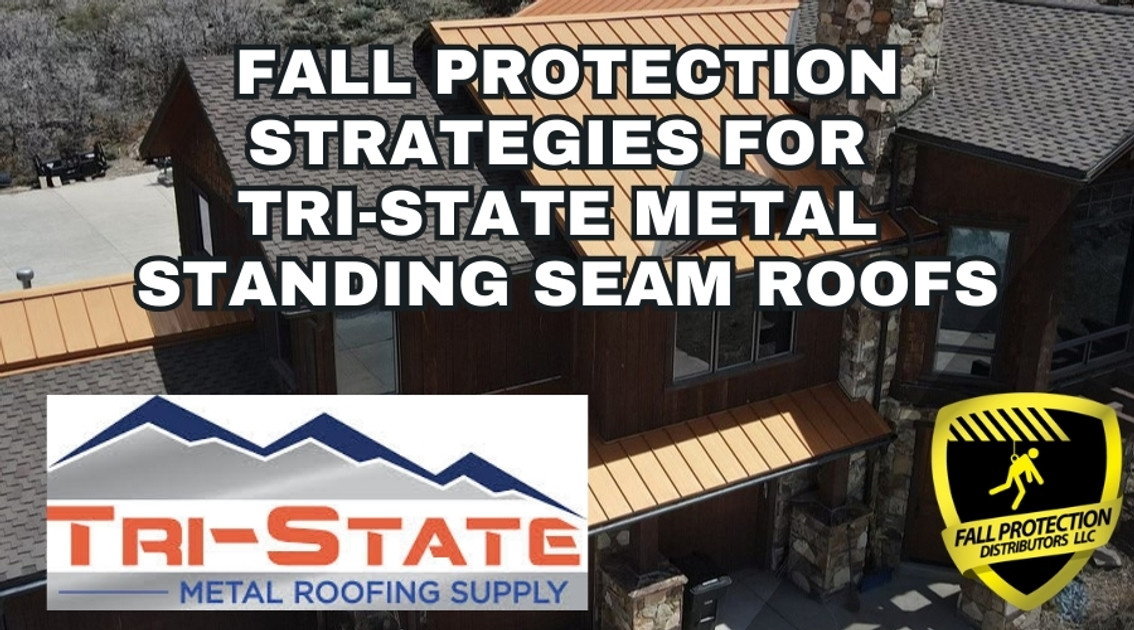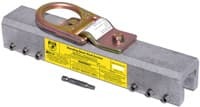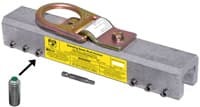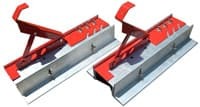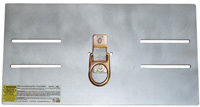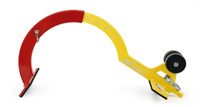Fall Protection Strategies For Tri-State Metal Roofing Standing Seam
Posted by Howie Scarboro - CEO Fall Protection Distributors, LLC on Aug 19th 2025
See the Roof Anchor Compatibility Chart for Tri-State Metal Roofing Supply Standing Seam Panels.

Who Is Tri-State Metal Roofing Supply?
Utah weather doesn't play favorites. Heavy snow in Ogden, blistering heat in St. George, and everything else in between can push a roof to its limits.
Tri-State Metal Roofing Supply has built its reputation on providing the kind of steel roofing systems that withstand pressure and perform reliably. With three locations in Ogden, Payson, and St. George, they've become a go-to resource for contractors, builders, and homeowners who want dependable, American-made steel roofing and siding.
One of the most significant advantages they bring to the table is complete in-house manufacturing. Panels and trim aren't outsourced or delayed. They're cut and bent on site, which often means same-day pickup for custom orders. That speed and control also enable Tri-State to maintain competitive pricing and consistent quality. They back every product they make with warranties that protect the customer.
Their product range encompasses everyday staples, such as Tuff Rib and R Panel, for affordable, exposed fastener roofing, as well as corrugated and versatile wall and soffit panels. Where they make a name for themselves, though, is with standing seam. For low-slope commercial or residential projects, their mechanical seam systems—SS200 and SS210A—provide watertight protection with heavier gauges for long-term strength. For homeowners who want a sleek look without the hassle of visible screws, their snaplock panels are hard to beat. These features include floating clip systems, concealed fasteners, a 130 mph wind rating, and a 40-year paint warranty. In other words, it's a system built to look good and last.
Tri-State doesn't stop at panels. They also produce trim, flashing, ridge caps, and custom details that make an installation feel complete and finished. Whether it's a contractor tackling a big commercial job or a DIYer working on a backyard shop, Tri-State offers the materials and support to get it done right the first time.

Why Are Compatible Fall Protection Anchors Critical For Tri-State Roofs?
Standing seam roofs present a unique challenge in terms of safety.
Unlike traditional shingle or screw-down metal roofs, you can't just lag bolt an anchor through the panel and call it good. Doing so can compromise the system's watertight seal and void the warranty before the first snowfall. That's the balancing act: you need OSHA and ANSI-rated fall protection, but you can't damage the very roof you're trying to work on.
This challenge is why anchor and roof compatibility become critical. Tri-State's panels, whether they use their snaplock or mechanical seam systems, rely on concealed fasteners and interlocking seams to remain weather-tight. Punch a hole in that system and you've just invited leaks, rust, and expensive callbacks. Contractors are aware of this, and so are building owners. That's why the best approach is to use non-penetrating, seam-mounted anchors that grip the standing seam itself without drilling or cutting into the panel.
Compatible anchors do more than protect the roof. They also protect the workers who trust them to arrest a fall. OSHA and ANSI standards set the bar high for strength, testing, and reliability. The right anchor allows crews to tie off confidently, move freely across the roof, and stay compliant with safety regulations. The wrong anchor, or worse, no anchor at all, puts both the project and the people at risk.
For Tri-State's roofs, the key is to match the proper fall protection equipment to the specific seam profile and gauge of steel. With the proper anchors, you can keep workers safe, preserve warranties, and maintain the clean look of a standing seam system without a single unnecessary hole in the metal. Let's go through the standing seam profiles and discuss the fall protection options for each panel.
SS200 Single Lock Mechanical Panels

Tri-State Metal Roofing Supply built the SS200 to deliver long-term performance in harsh conditions.
It features a 2-inch single-flange mechanical seam that locks together with a seamer tool, providing the panel with outstanding weather resistance, even in low-slope applications. Roof pitches as low as 1/12 are compatible, making the SS200 popular for commercial buildings, residential homes, and agricultural projects. See the Roof Anchor Compatibility Chart for Tri-State Metal Roofing Supply SS200 Single Lock Standing Seam Panels.
Two gauges are available, each with its strengths. The 24-gauge version measures 18.25 inches and offers the stiffness required for demanding environments. The 26-gauge panel measures 14.75 inches wide and offers good durability. Still, because of the lighter steel, it requires more caution when selecting safety equipment. Both options feature concealed fasteners, protecting against the elements and resulting in a modern, fully sealed roofline.
Fall Protection for SS200 Panels
Safety on an SS200 roof starts with choosing anchors that won't damage the system.
Traditional mechanically fastened anchors would puncture the metal and compromise the very weather-tightness that standing seam roofs are known for. Instead, non-penetrating anchors are the best option.
For the 24-gauge SS200, the complete Standing Seam Roof Anchor system is available. The SSRA1 Seam Anchor clamps directly onto the seam, eliminating the need for a single panel penetration. Once in place, it serves as a single-worker tie-off and as the base for a complete safety platform. The SSRA1 features a universal-fit one-piece aluminum body with twelve stainless steel set screws. It is lightweight, has a universal fit, and is tested to a 14,000-pound ultimate breaking strength.
When walkboards are required, workers can mount SSRA2 Adjustable Roof Jack Adapters on top of the seam anchors to secure 10-foot wooden walkboards. That means workers can move tools, panels, and equipment with confidence across the roof's surface. The SSRA2 Roof Jacks are adjustable for various roof pitches and seam heights, featuring adjustable, padded side support feet.
Add the SSRA3 Anchor Plates for mounting a temporary horizontal lifeline assembly for multiple workers. The SSRA HLL kit includes everything needed to mount a compliant, two-person lifeline system directly to the SSRA anchors. Rope, tensioners, energy absorbers, anchor plates, and hardware all come together in one package, making it a turnkey option for crews who need to stay mobile while maintaining 100% tie-off.
For longer-term safety needs, there's an industry exclusive: the Super Anchor 120-foot Permanent Horizontal Lifeline Kit. Super Anchor designed this kit for standing seam roofs. It installs a permanent, OSHA-approved tie-off system without requiring penetrations. This kit provides building owners and facility managers with peace of mind, knowing that maintenance crews will always have a safe and reliable anchor point ready for use. The kit includes non-penetrating seam clamps with aluminum baseplates, 5" riser posts, and 120 feet of galvanized steel cable.
On steeper applications, the Ridge Pro Steep Assist can be added for quick tie-off at the peak, making it an excellent complement to the SSRA system. The Ridge Pro Steep Assist is for 6/12 to 12/12 roofs. It is a fast and convenient way to secure vertical lifelines to roofs, ensuring 100% tie-off for workers.
When it comes to the 26-gauge SS200, the lighter steel doesn't allow for seam-mounted anchors. In such cases, the Ridge Pro is the best choice, offering a simple and non-invasive solution for lighter gauge panels while preserving the panel's finish.
SS210A Double Lock Mechanical Panels

The SS210A panel from Tri-State Metal Roofing Supply is a workhorse in the standing seam family.
Featuring a 2-inch double-flange mechanical seam, it offers even greater strength and weather resistance than its single-lock counterpart. This system can handle roof pitches as low as 1/12, making it a top choice for low-slope commercial projects, agricultural buildings, and residential designs that demand long-term performance. See the Roof Anchor Compatibility Chart for Tri-State Metal Roofing Supply SS210A Double Lock Standing Seam Panels.
Like the SS200, the SS210A is available in two gauges. The 24-gauge version measures 18.25 inches in width and delivers the stiffness required for more demanding jobs. The 26-gauge option measures 14.75 inches wide and, while durable, is more limited in terms of fall protection compatibility due to its lighter steel construction. Both versions utilize a concealed fastener system that ensures the roof surface remains watertight and smooth. Installation requires a seamer tool to fully lock the panels, resulting in a robust, leak-proof system that pairs strength with a clean, professional appearance.
Fall Protection for SS210A Panels
The safety rules for the SS210A are very similar to those of the SS200. The steel gauge determines which systems you can use, and non-penetrating anchors protect the panel's integrity.
On 24-gauge SS210A panels, contractors have the complete flexibility of the Standing Seam Roof Anchor system. The SSRA1 Seam Anchor provides a non-penetrating foundation by clamping securely onto the seam with stainless steel set screws. Crews often add the SSRA2 Adjustable Roof Jack Adapters to support 10-foot wooden walkboards, creating a stable footing across large roof areas. For projects with multiple workers, the SSRA3 Anchor Plate allows attachment of 100-foot temporary horizontal lifelines, expanding the safety system into a versatile solution for complex jobs.
That's where the SSRA 100-foot Horizontal Lifeline Kit comes in. This comprehensive package includes rope, energy absorbers, anchor plates, tensioners, and all necessary hardware to span long roof sections with two workers tied off safely. It's one of the most efficient ways to maintain 100% tie-off compliance without sacrificing mobility.
For sites that demand a long-term solution, the Super Anchor 120-foot Permanent Horizontal Lifeline Kit provides unmatched security. As the only industry-exclusive system explicitly designed for standing seam roofs, it ensures maintenance crews always have a permanent, OSHA- and ANSI-compliant tie-off system ready to go—without a single penetration into the panel.
The Ridge Pro Steep Assist is also an option on 24-gauge panels with slopes between 6/12 and 12/12, offering quick setup for peak tie-offs or short-duration tasks.
The lighter 26-gauge SS210A doesn't support seam-mounted anchors. In this case, the Ridge Pro becomes the safest and most reliable option. By hooking over the ridge, it preserves the roof's clean, watertight system while still giving workers the tie-off they need to remain compliant and protected.
Snaplock Nailstrip 16-inch Panels

Tri-State Metal Roofing Supply developed the Snaplock panel to facilitate quicker and simpler installation without compromising durability or performance.
Unlike the SS200 and SS210A mechanical seam panels, the Snaplock system uses a snap-together concealed fastener that eliminates the need for a seamer tool. That simple difference makes it a favorite among contractors who need speed on the jobsite and DIY installers who want a professional finish without renting specialized equipment. See the Roof Anchor Compatibility Chart for Tri-State Metal Roofing Supply Snaplock Nailstrip Standing Seam Panels.
Once installed, the Snaplock has a seam height of 1.5 inches and an effective panel width of 15.5 inches. It's manufactured from 26-gauge American-made steel, offering strength and corrosion resistance for residential and light commercial projects. A floating clip system enables the panel to expand and contract with temperature fluctuations, thereby preventing oil canning and ensuring the fasteners remain secure over time. Hiding all the screws beneath the seams keeps the roof surface smooth, watertight, and free of penetrations.
Performance-wise, the Snaplock carries a 130 mph wind rating and a 40-year paint warranty. That combination makes it a dependable choice in storm-prone regions while ensuring the roof looks sharp for decades. The system is rated for use on slopes as low as 3/12, making it a mid- to steep-slope option compared to the low-pitch capabilities of Tri-State's mechanical seam panels. Applications include residential homes, accent roofs, and small commercial projects where clean lines, color longevity, and straightforward installation are priorities.
Fall Protection for Snaplock Panels
Because the Snaplock panel is made from lighter 26-gauge steel and relies on its floating clip system to accommodate expansion, it isn't compatible with seam-mounted anchors like the SSRA1.
Clamping onto this type of seam can deform the panel or interfere with its ability to move correctly, which risks both leaks and warranty issues.
Instead, the safest and most reliable option for this panel is the Ridge Pro Steep Assist Anchor. The Ridge Pro sets over the peak of the roof and creates a secure tie-off point without ever touching the seam or penetrating the metal surface. It's an excellent match for Snaplock because it preserves the system's weather-tight finish while giving workers OSHA- and ANSI-compliant fall protection.
The Ridge Pro is especially effective on Snaplock projects with slopes between 6/12 and 12/12, where workers require extra stability and a straightforward method for staying tied off. While it doesn't allow for horizontal lifelines or walk board systems like the SSRA setup on heavier panels, it still provides critical protection and peace of mind for installers, inspectors, and maintenance crews working on Snaplock roofs.
Metal Roof Anchor Panel Compatibility For Tri-State Metal Roofing Supply
| SS200 Panel 24 ga. |
SS210A Panel 24 ga. |
Snaplock Nailstrip Panel 26 ga. |
|
|---|---|---|---|
| YES | YES | NO | |
| YES | YES | NO | |
| YES | YES | NO | |
| YES | YES | NO | |
| YES | YES | YES |
Contact Us For More Information
For further details on roofing solutions and fall protection systems, contact us at 863-703-4522 or www.StandingSeamRoofAnchor.com. Let's work together to make your roofing projects safe, beautiful, and built to last. For more safety tips, refer to OSHA's 48-page Fall Protection Manual. Once you have determined the most suitable anchors for your roof system, download our free Anchor Inspection Form.
Safety Tips For Standing Seam Roofs
Use Specialized Anchor Systems for Standing Seam Roofs
Standing seam panels are built to shed water and last for decades, but require specialized fall protection anchors. Drilling through a seam to attach an anchor defeats the purpose and can compromise the roof before the job even begins. Seam-mounted anchors, designed for standing seam systems, clamp tightly without requiring a single panel penetration, thereby preserving both the warranty and the watertight seal. It's the difference between a roof that performs for 40 years and one that fails after the first storm.
Ensure Proper Footwear for Stability
Footing makes all the difference on a slick roof. The proper boots—deep tread, solid ankle support, and slip-resistant soles—are as crucial as a harness when the pitch gets steep or the panels are wet. Proper footwear doesn't just prevent slips; it also reduces fatigue, providing workers with the balance and stamina they need to stay focused throughout long shifts.
Develop OSHA-Compliant Safety Plans
Every roofing project should start on paper before it starts on the ladder. A written safety plan outlines fall protection methods, rescue procedures, and the roles of each worker. More than a formality, it's a roadmap that keeps everyone aligned when conditions change or hazards pop up. Crews that know the plan are crews that stay ahead of accidents.
Encourage the Use of Trauma Straps
A fall arrest system saves a life instantly, but the minutes that follow can be just as critical. Suspension trauma sets in fast when blood flow is restricted, and that's where trauma straps come in. They let a suspended worker relieve pressure, restore circulation, and buy the rescue team precious time. For something so small and inexpensive, they're one of the smartest add-ons you can put on a harness.
Prioritize Ladder Safety Training
Some of the worst falls don't happen on the roof at all—they happen on the ladder. Teaching crews the basics, such as the 4-to-1 rule and proper tie-offs, and always maintaining three points of contact drastically reduces the odds of a ladder mishap. Short, visual training sessions go a long way, especially when roof access points change from job to job.
Set Up Protective Guardrail Barriers for Work Zones
Passive protection is one of the most underrated safety tools on a job site. Guardrails don't require training, adjustments, or worker action. Around roof edges, skylights, or access hatches, they provide a clear visual boundary and a physical barrier that stops slips from becoming falls. On crowded sites, that simplicity can be a lifesaver.
Equip Workers with High-Quality Safety Gear
Good gear isn't optional. A harness that fits right, fresh lanyards, and OSHA- and ANSI-rated SRLs provide workers with the protection they can count on. Gear checks should be routine, not occasional. When workers feel confident in their equipment, they can focus on the job instead of second-guessing their tie-off.
Consult Experts for Curved Metal Panels
Curved roofs are impressive, but they present unique challenges. The bend in the metal changes how seams behave, and what works on a straight panel can fail on a radius. Before tying off, bring in a safety expert who understands curved systems. They can evaluate seam compatibility and recommend anchors or lifeline setups that won't put the roof—or the crew—at risk.
Install Permanent Roof Anchor Systems
For buildings that see constant roof traffic—whether it's HVAC techs, solar installers, or maintenance crews—permanent anchors are worth every penny. Installed once and flashed into the roof system, they provide reliable tie-off points year-round. Workers don't waste time setting up temporary systems, and building owners get peace of mind knowing safety is built in from the start.
Promote a Culture of Safety
Rules and gear only go so far if the crew doesn't buy into them. A culture of safety means that workers feel responsible for themselves and for one another. It shows up in quick morning check-ins, in speaking up when something looks off, and in knowing leadership takes concerns seriously.
Disclaimer
The views, recommendations, and information presented in this blog are solely those of the author and do not necessarily reflect the opinions or positions of the featured panel manufacturer, its brands, subsidiaries, or parent companies. Customers are strongly encouraged to contact the roof panel manufacturer directly for inquiries regarding fall protection compatibility with their products and to address any potential warranty issues that may arise after installing our products.

